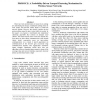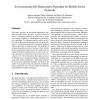633 search results - page 93 / 127 » Coverage in heterogeneous sensor networks |
AINA
2008
IEEE
14 years 2 months ago
2008
IEEE
There has been proliferation of research on seeking for distributing the energy consumption among nodes in each cluster and between cluster heads to extend the network lifetime. H...
INFOCOM
2011
IEEE
12 years 11 months ago
2011
IEEE
—In wireless sensor networks, multiple-coverage, in which each point is covered by more than one sensor, is often required to improve detection quality and achieve high fault tol...
INFOCOM
2008
IEEE
14 years 2 months ago
2008
IEEE
—Sleep-wake scheduling is an effective mechanism to prolong the lifetime of energy-constrained wireless sensor networks. However, it incurs an additional delay for packet deliver...
INFOCOM
2009
IEEE
14 years 2 months ago
2009
IEEE
—We present the Flash flooding protocol for rapid network flooding in wireless sensor networks. Traditional flooding protocols can be very slow because of neighborhood content...
AROBOTS
2002
13 years 8 months ago
2002
This paper describes an incremental deployment algorithm for mobile sensor networks. A mobile sensor network is a distributed collection of nodes, each of which has sensing, compu...


